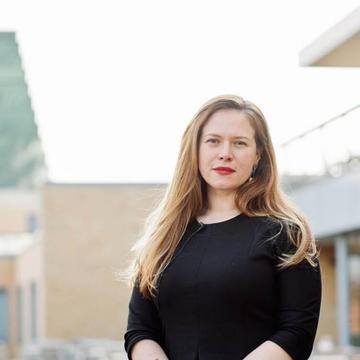Beyond the tea-towels: research, innovation and the business of heritage
Said Business School Talk, 7 Feb 2020
Alice Purkiss introduces the National Trust Partnership at the University of Oxford
The National Trust Partnership is a collaboration between Oxford University and the National Trust which has been established to create new opportunities for interdisciplinary research, knowledge exchange, and public engagement with research and training. The Partnership Lead, Alice Purkiss, spoke at Oxford University’s Saïd Business School on 7 February 2020 as part of the School’s Engaging with the Humanities series.
One purpose, many facets
The National Trust was founded in 1895 and incorporated in 1907 as a charity with the purpose of ‘promoting the permanent preservation for the benefit of the nation of lands and tenements (including buildings) of beauty or historic interest and as regards lands for the preservation (so far as practicable) of their natural aspect features and animal and plant life.’ This has been abbreviated to the motto ‘For everyone, for ever.’
125 years after its founding, the National Trust now owns a very wide range of properties, covering historic houses, parks, gardens, farmland, and swathes of coastline, and a collection which contains, as Purkiss put it, everything ‘from teaspoons to Turners, rat traps to Rembrandts’.
But for people interested in business and organisations, a perhaps more fascinating aspect of the Trust is the way in which it harnesses so very many different activities in pursuit of its purpose, and the additional unintended benefits that accrue to different stakeholders.
Most obviously it is a heritage business and membership organisation, deriving income from its almost 6 million members, who each pay a membership fee, and from the entrance fees it charges non-members. As a charity, it receives money in gifts, donations, and grants, and is supported by over 65,000 volunteers. It is also a landlord, leasing properties and farms to tenants; a holiday company providing accommodation and conservation-focused working holidays; a caterer, running 350 cafes which make and sell 11 million hot drinks and 2 million fruit scones each year; and a publisher and retailer, selling books and heritage-themed products in a chain of National Trust shops and online.
In addition, every year people who would not consider visiting a historic house or eating a scone benefit from the 30 parkruns hosted on National Trust land; and the organisation’s volunteer schemes have earnt it membership of the National Council for Voluntary Youth Services in recognition of its work for the personal and social development of young people.
The intersection of heritage and history
The University of Oxford’s collaboration with the National Trust started in 2013 when the History Faculty’s Dr Oliver Cox finished his DPhil and became one of the University’s first Knowledge Exchange Fellows.
This developed into a Knowledge Transfer Partnership in 2016 which created Trusted Source, an online knowledge bank of accessible, short articles written by academics and heritage specialists that link National Trust places through themes and encourage exploration of the properties and the organisation. As Purkiss explained, the articles are peer-reviewed and the project was ‘successful in quickly establishing a mechanism for interdisciplinary research communication’. It also yielded further benefits and activities, from workshops to publications and conferences, and the University has been able to support the National Trust in becoming an Independent Research Organisation itself.
The National Trust’s large collection of historic houses (most acquired as the result of punitive death duties after the Second World War) has rather unfairly led to a perception that it indulges a Downton-Abbey-style rose-tinted view of the past. Purkiss explained that the involvement of academics in writing the Trusted Source articles, undertaking new research, sharing knowledge with volunteers and staff, supporting research training and creating ‘interpretation boards’ has allowed the Trust to engage audiences on a deeper level and address some of the more challenging questions linked with their properties. For example, the Partnership is currently supporting research at Powis Castle in Wales which houses the Clive Collection, one of the most important collections of Indian artefacts outside India amassed by Lord Robert Clive, his son Edward, and daughter-in-law Henrietta during their time in India with the East India Company. Primary research is being undertaken by Dr Kieran Hazzard, Knowledge Exchange Fellow at the Ashmolean Museum, with support from 19 student interns to date, with findings being shared with the property’s visitors, volunteers, and staff. Purkiss said that having a named academic undertaking new research, feeding into interpretative guides and sharing knowledge in an accessible way meant that complex subjects and difficult questions could be addressed with increased confidence.
Partnership and innovation
Oxford’s partnership with the National Trust was noted approvingly in the Government-commissioned Mendoza Review of museums in England in 2017, and named Partnership of the Year at PraxisAuril’s KE Awards in 2019. It won Purkiss herself one of the Vice-Chancellor’s Innovation Awards in 2018.
Purkiss said that she was particularly pleased by this as innovation is ‘usually thought of as looking scientific’. She was keen to emphasise that the Humanities is also ‘a space that can foster innovation … Innovation is not just about gadgets but about new ways of thinking or applying new ideas in different contexts.’
Collaboration is an important way in which ideas can be translated into different contexts, and also a way in which ideas and activities can expand. Oxford’s partnership with the National Trust may have started with the History Faculty, but it now also embraces a fellowship funded by the Social Sciences Division as well as an Engineering Science project looking at landscapes and incorporating climate change.
‘Our guiding principle has always been about scalability and mutual benefit,’ said Purkiss. ‘Different motivations are fine: we shouldn’t expect everyone to come into a partnership with the same ambitions. But both sides should create value from the collaboration.’
This is a re-post from the Said Business School. Find out more about the National Trust Partnership here.

Image caption: Image © Said Business School


